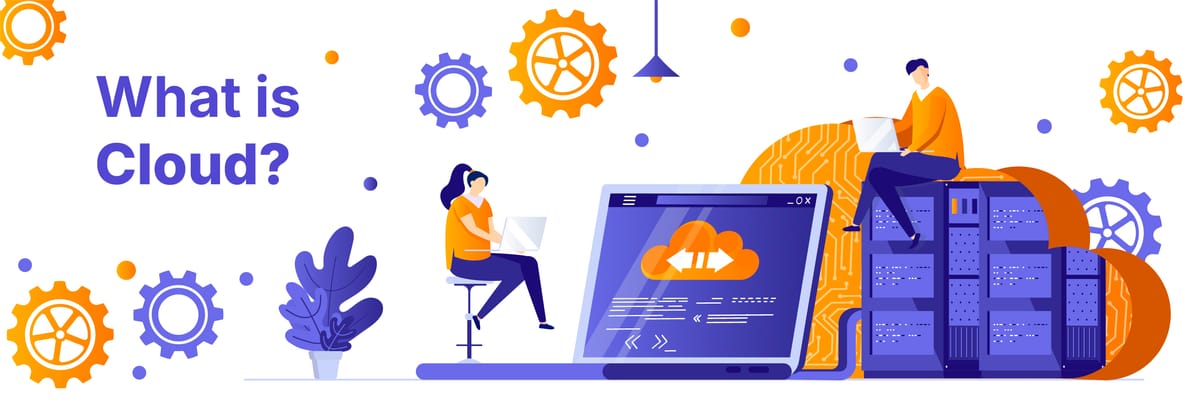What is Cloud?
Discover the essentials of cloud computing: how it works, its benefits, and real-world applications. Learn about IaaS, PaaS, and SaaS, and understand why the cloud is transforming the digital landscape. Perfect for tech enthusiasts and businesses alike.

In today's digital age, the term "cloud" is thrown around frequently, but what does it really mean? If you're new to the tech world or simply curious, this post will break down the concept of the cloud and its significance in modern technology.
What is the Cloud?
At its core, the cloud refers to servers that are accessed over the internet, along with the software and databases that run on those servers. Cloud servers are located in data centers all over the world. By using cloud computing, users and companies don’t have to manage physical servers themselves or run software applications on their own machines.
How does cloud computing works?
Cloud computing operates on a fundamental principle of virtualization and distributed computing. When you access a cloud service, your request is sent to a network of servers in a data center. These servers use virtualization technology to create multiple virtual machines (VMs) from a single physical server, maximizing resource utilization. The cloud's management software, often called the "hypervisor," allocates these resources dynamically based on demand. When you request a service or resource, the system identifies available capacity across its network and provisions it to you. This process happens in real-time, allowing for rapid scaling. Data is typically stored across multiple servers for redundancy and faster access. Load balancers distribute incoming requests across multiple servers to ensure optimal performance. The cloud provider handles all the backend complexities, including server maintenance, security updates, and data backups. Users interact with the cloud through web interfaces or APIs, which abstract away the underlying infrastructure. This entire system is designed to be highly available, fault-tolerant, and scalable, allowing users to access powerful computing resources on-demand without the need to manage the physical hardware themselves.
Key Characteristics of the Cloud
- On-Demand Self-Service: Users can access computing resources as needed without human interaction with each service provider.
- Broad Network Access: Services are available over the network and accessed through standard mechanisms that promote use by heterogeneous thin or thick client platforms (e.g., mobile phones, tablets, laptops, and workstations).
- Resource Pooling: The provider’s computing resources are pooled to serve multiple consumers using a multi-tenant model, with different physical and virtual resources dynamically assigned and reassigned according to demand.
- Rapid Elasticity: Capabilities can be elastically provisioned and released, in some cases automatically, to scale rapidly outward and inward commensurate with demand.
- Measured Service: Cloud systems automatically control and optimize resource use by leveraging a metering capability at some level of abstraction appropriate to the type of service (e.g., storage, processing, bandwidth, and active user accounts).
Types of Cloud Services
Cloud computing services are typically divided into three categories:
- Infrastructure as a Service (IaaS): Provides virtualized computing resources over the internet. Examples include Amazon Web Services (AWS) and Microsoft Azure.
- Platform as a Service (PaaS): Offers hardware and software tools over the internet, typically those needed for application development. Google App Engine is an example.
- Software as a Service (SaaS): Delivers software applications over the internet, on a subscription basis. Examples include Google Workspace and Salesforce.
Benefits of Cloud Computing
- Cost Efficiency: Reduces the capital expense of buying hardware and software.
- Scalability: Easily scale up or down based on demand.
- Performance: Regular updates to the latest generation of fast and efficient computing hardware.
- Security: Offers a broad set of policies, technologies, and controls that strengthen your security posture overall.
- Accessibility: Access your data and applications from anywhere, at any time.
Challenges and Considerations
While the cloud offers numerous benefits, it also presents challenges such as data privacy concerns, potential downtime, and the need for a reliable internet connection. Organizations must carefully consider these factors when migrating to the cloud.
Conclusion
The cloud is a transformative technology that has reshaped the way we store, access, and manage data. By understanding its core principles and benefits, businesses and individuals can make informed decisions about how to leverage cloud computing to meet their needs. As technology continues to evolve, the cloud will undoubtedly play an even more integral role in our digital lives.
